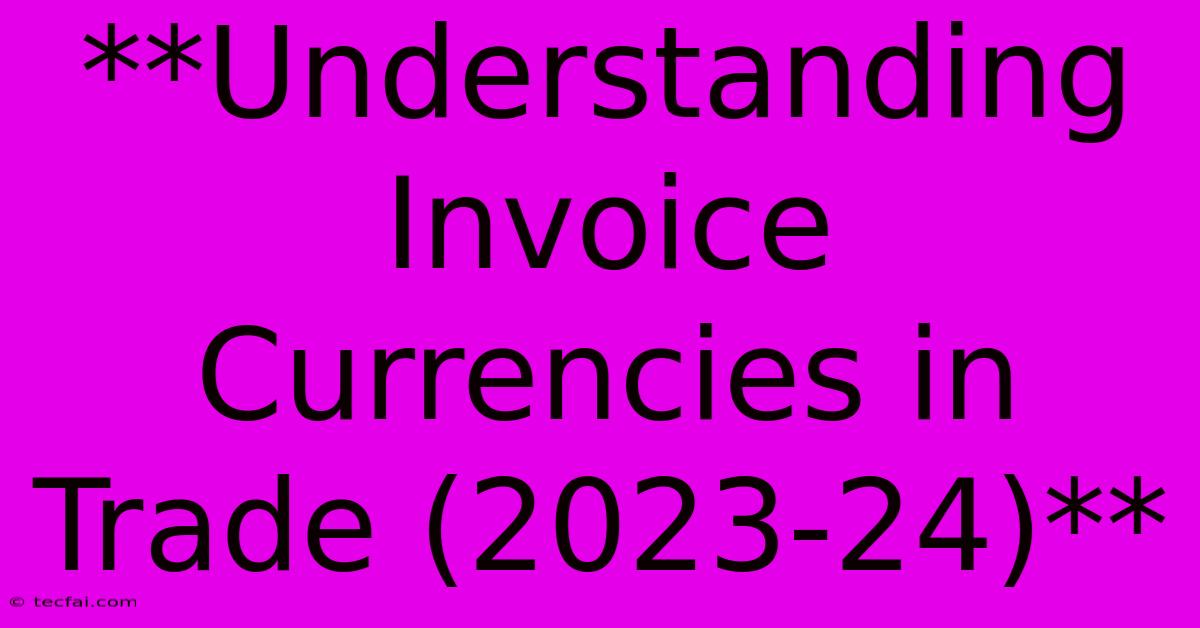**Understanding Invoice Currencies In Trade (2023-24)**

Discover more detailed and exciting information on our website. Click the link below to start your adventure: Visit Best Website tecfai.com. Don't miss out!
Table of Contents
Understanding Invoice Currencies in Trade (2023-24)
The global marketplace is a complex web of transactions, with businesses spanning continents and currencies. One of the key elements in any international trade deal is the invoice currency. This seemingly simple detail can significantly impact your profitability and risk exposure. This guide delves into the crucial aspects of invoice currencies, equipping you with the knowledge to navigate this vital aspect of international trade in 2023-24.
What is an Invoice Currency?
The invoice currency is simply the currency in which the final invoice for goods or services is issued. It determines the price a buyer pays for the products or services, and the currency in which the seller receives payment.
Why is Invoice Currency Important?
1. Exchange Rate Fluctuations: The most significant impact of invoice currency is exposure to exchange rate fluctuations. If the invoice currency is different from your home currency, any changes in the exchange rate between the two can significantly impact your profit margins.
2. Payment Terms: The chosen invoice currency can influence the payment terms agreed upon. Some currencies are more stable than others, leading to more favorable payment terms for buyers or sellers depending on the situation.
3. Contractual Obligations: The invoice currency is a crucial part of the sales contract and legally binds both parties to the agreed terms.
Factors to Consider When Choosing an Invoice Currency
1. Market Standards: Investigate the common practice in your industry and with your trading partners. Some industries might favor specific currencies due to historical reasons or market trends.
2. Currency Stability: Choose a currency that is relatively stable and less prone to significant fluctuations. Stable currencies offer more predictability for both buyer and seller.
3. Transaction Costs: Consider the potential fees associated with converting currencies. Some currencies may have higher transaction costs than others.
4. Payment Terms and Risks: Evaluate the payment terms you are comfortable with. If you are comfortable with a longer payment period, you might be more inclined to accept a less stable currency.
Popular Invoice Currencies
1. US Dollar (USD): Widely accepted as the global reserve currency, USD is often used in international trade. Its stability and liquidity make it a popular choice for both buyers and sellers.
2. Euro (EUR): As the currency of the Eurozone, EUR is a significant player in international trade, especially in European transactions.
3. Japanese Yen (JPY): JPY is often used in transactions with Japan and East Asian countries.
4. British Pound (GBP): GBP remains a popular currency for trade with the UK and Commonwealth countries.
5. Chinese Yuan (CNY): With the growing influence of China in global trade, CNY is gaining traction as an invoice currency.
Strategies for Managing Currency Risk
1. Hedging: Employ hedging strategies like forward contracts or options to lock in a specific exchange rate for a future transaction, mitigating potential losses from unfavorable exchange rate movements.
2. Diversification: Spread your transactions across multiple currencies to reduce your overall exposure to any single currency's fluctuations.
3. Currency Clauses: Include clauses in your contracts that specify how potential exchange rate fluctuations will be handled.
Conclusion
Choosing the right invoice currency is a strategic decision that can impact your financial outcomes. By carefully considering the factors outlined above and understanding the potential risks and rewards, you can make informed decisions that contribute to successful international trade. Remember to stay informed about global currency trends and consult with financial experts to mitigate risks and optimize your trading strategies.

Thank you for visiting our website wich cover about **Understanding Invoice Currencies In Trade (2023-24)**. We hope the information provided has been useful to you. Feel free to contact us if you have any questions or need further assistance. See you next time and dont miss to bookmark.
Featured Posts
-
Trump Cases Smith Plans For Closure
Nov 07, 2024
-
Barcelona Dominates Crvena Zvezda In Champions League
Nov 07, 2024
-
Ray Hadley Calls Time On 2 Gb Career
Nov 07, 2024
-
Canada Orders Tik Tok Business Shutdown
Nov 07, 2024
-
Trevor Sorbies Terminal Cancer Battle
Nov 07, 2024
